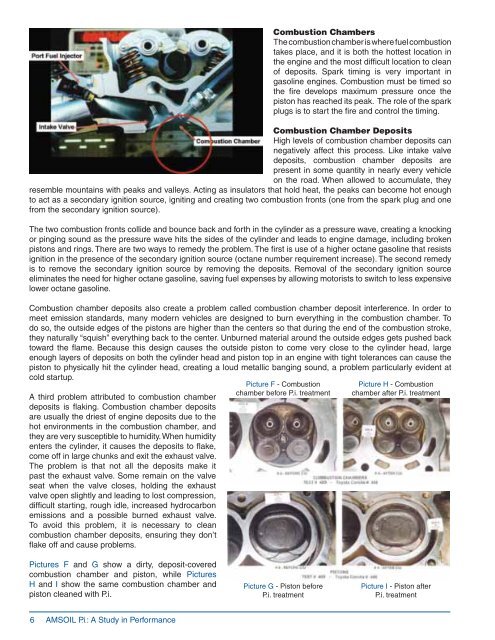AMSOIL P.i. - A Study in Performance (G2543) - Synthetic Motor Oil
AMSOIL P.i. - A Study in Performance (G2543) - Synthetic Motor Oil
AMSOIL P.i. - A Study in Performance (G2543) - Synthetic Motor Oil
Create successful ePaper yourself
Turn your PDF publications into a flip-book with our unique Google optimized e-Paper software.
Combustion Chambers<br />
The combustion chamber is where fuel combustion<br />
takes place, and it is both the hottest location <strong>in</strong><br />
the eng<strong>in</strong>e and the most difficult location to clean<br />
of deposits. Spark tim<strong>in</strong>g is very important <strong>in</strong><br />
gasol<strong>in</strong>e eng<strong>in</strong>es. Combustion must be timed so<br />
the fire develops maximum pressure once the<br />
piston has reached its peak. The role of the spark<br />
plugs is to start the fire and control the tim<strong>in</strong>g.<br />
Combustion Chamber Deposits<br />
High levels of combustion chamber deposits can<br />
negatively affect this process. Like <strong>in</strong>take valve<br />
deposits, combustion chamber deposits are<br />
present <strong>in</strong> some quantity <strong>in</strong> nearly every vehicle<br />
on the road. When allowed to accumulate, they<br />
resemble mounta<strong>in</strong>s with peaks and valleys. Act<strong>in</strong>g as <strong>in</strong>sulators that hold heat, the peaks can become hot enough<br />
to act as a secondary ignition source, ignit<strong>in</strong>g and creat<strong>in</strong>g two combustion fronts (one from the spark plug and one<br />
from the secondary ignition source).<br />
The two combustion fronts collide and bounce back and forth <strong>in</strong> the cyl<strong>in</strong>der as a pressure wave, creat<strong>in</strong>g a knock<strong>in</strong>g<br />
or p<strong>in</strong>g<strong>in</strong>g sound as the pressure wave hits the sides of the cyl<strong>in</strong>der and leads to eng<strong>in</strong>e damage, <strong>in</strong>clud<strong>in</strong>g broken<br />
pistons and r<strong>in</strong>gs. There are two ways to remedy the problem. The first is use of a higher octane gasol<strong>in</strong>e that resists<br />
ignition <strong>in</strong> the presence of the secondary ignition source (octane number requirement <strong>in</strong>crease). The second remedy<br />
is to remove the secondary ignition source by remov<strong>in</strong>g the deposits. Removal of the secondary ignition source<br />
elim<strong>in</strong>ates the need for higher octane gasol<strong>in</strong>e, sav<strong>in</strong>g fuel expenses by allow<strong>in</strong>g motorists to switch to less expensive<br />
lower octane gasol<strong>in</strong>e.<br />
Combustion chamber deposits also create a problem called combustion chamber deposit <strong>in</strong>terference. In order to<br />
meet emission standards, many modern vehicles are designed to burn everyth<strong>in</strong>g <strong>in</strong> the combustion chamber. To<br />
do so, the outside edges of the pistons are higher than the centers so that dur<strong>in</strong>g the end of the combustion stroke,<br />
they naturally “squish” everyth<strong>in</strong>g back to the center. Unburned material around the outside edges gets pushed back<br />
toward the flame. Because this design causes the outside piston to come very close to the cyl<strong>in</strong>der head, large<br />
enough layers of deposits on both the cyl<strong>in</strong>der head and piston top <strong>in</strong> an eng<strong>in</strong>e with tight tolerances can cause the<br />
piston to physically hit the cyl<strong>in</strong>der head, creat<strong>in</strong>g a loud metallic bang<strong>in</strong>g sound, a problem particularly evident at<br />
cold startup.<br />
A third problem attributed to combustion chamber<br />
deposits is flak<strong>in</strong>g. Combustion chamber deposits<br />
are usually the driest of eng<strong>in</strong>e deposits due to the<br />
hot environments <strong>in</strong> the combustion chamber, and<br />
they are very susceptible to humidity. When humidity<br />
enters the cyl<strong>in</strong>der, it causes the deposits to flake,<br />
come off <strong>in</strong> large chunks and exit the exhaust valve.<br />
The problem is that not all the deposits make it<br />
past the exhaust valve. Some rema<strong>in</strong> on the valve<br />
seat when the valve closes, hold<strong>in</strong>g the exhaust<br />
valve open slightly and lead<strong>in</strong>g to lost compression,<br />
difficult start<strong>in</strong>g, rough idle, <strong>in</strong>creased hydrocarbon<br />
emissions and a possible burned exhaust valve.<br />
To avoid this problem, it is necessary to clean<br />
combustion chamber deposits, ensur<strong>in</strong>g they don’t<br />
flake off and cause problems.<br />
Picture F - Combustion<br />
chamber before P.i. treatment<br />
Picture H - Combustion<br />
chamber after P.i. treatment<br />
Pictures F and G show a dirty, deposit-covered<br />
combustion chamber and piston, while Pictures<br />
H and I show the same combustion chamber and<br />
piston cleaned with P.i.<br />
Picture G - Piston before<br />
P.i. treatment<br />
Picture I - Piston after<br />
P.i. treatment<br />
6 <strong>AMSOIL</strong> P.i.: A <strong>Study</strong> <strong>in</strong> <strong>Performance</strong>




